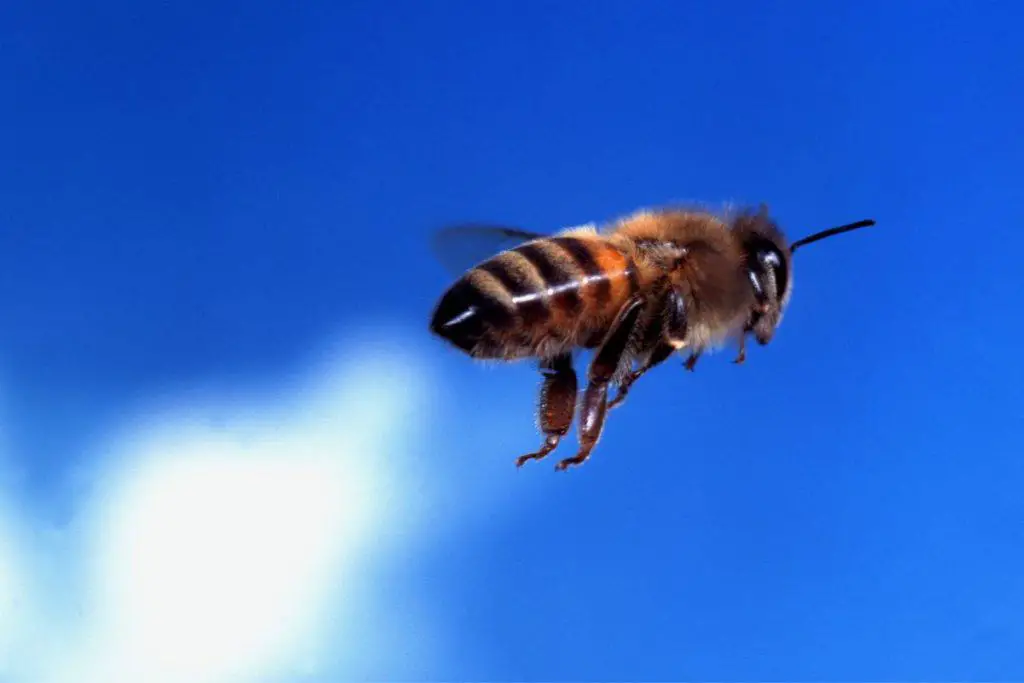Studies have shown that bees can fly for up to 5 miles without landing, and they can reach speeds of up to 15 miles per hour. This is impressive when you consider how small these insects are.
However, bees typically stay close to the hive and will only fly up to 1 mile or less in search of food. When foraging for pollen, they may also take short breaks in between flights to rest.
But, when does a bee know when to stop, and do they get tired from all this flying? let’s find out…
How Do Bees Know When To Stop Flying?
All bees possess what is called a “compass sense,” which gives them the ability to perceive the omnipresent magnetic field (MF) of the Earth. It also allows them to know when to stop flying.
For example, when we go running and get tired our brains tell us to stop for a break. Bees do the same thing, but it’s their compass sense that tells them when to stop flying.
Typically when a bee begins its flight, it sets off in a straight line. But as the bee approaches its destination, it starts to zigzag back and forth.
Scientists believe that this change in behavior is the bee’s way of orienting itself to its surroundings.
By constantly changing directions, the bee is able to take in more information about its surroundings “using its compass sense” and eventually find its way to the flowers it is searching for.
Once the bee has located the flowers, it will continue to fly back and forth between them until it has collected all the pollen it needs.
How Far Can Bees Fly In One Day?
As any beekeeper knows, bees are essential for pollinating plants. But how far can these hardworking insects fly in a single day?
According to research, bees will only travel up to one mile from the hive. However, the amount of flying they do can be anything up to 90,000 miles in one day.
For example, if a single honey bee can fly for up to six miles, and reach speeds of up to 15 miles per hour. This means that in a single day, a bee could easily travel around 90,000 miles.
To put this in perspective, this is equivalent to flying three times around the globe.
Think about it! if a bee is constantly on the move and flying in different directions, to and from the hive, but is still staying within the one-mile threshold by the end of the day that is a lot of flying!
Related Article:

Does Constantly Flying Have A Negative Impact On Their Health?
Bees are very hard workers and they are constantly flying from the hive to collect nectar and pollen. But, does this hard work have any negative impacts on their health?
Well, there have been reports of bees dying because of “combined stress” due to being overworked. Now, this doesn’t necessarily mean it was due to flying, however, this may contribute!
- When a bee has to travel too far from the hive, it can deplete its energy reserves quickly and cause exhaustion.
- Therefore, as much as bees need to fly in order to collect food, they also need rests in between flights so that they don’t become overworked and fatigued.
Are There Any Other Insects That Exhibit The Same Behavior?
When it comes to flying, bees are true champions. But are they the only insects that can fly for such long periods of time? Actually, yes! Many other insects exhibit similar behavior, such as dragonflies and moths.
Dragonflies are particularly impressive in this regard, as they can fly for up to six hours nonstop!
This is due to their unique anatomy which includes two pairs of wings with a special vascular system that helps keep them moving.
Moths also possess the ability to fly for long distances without rest. They use a combination of navigation methods, including the stars and ocean currents, to guide them on their journeys.
Overall, it is clear that flying for long periods of time is a skill that many different kinds of insects share!
Conclusion
So there you have it- now you know how far bees can fly without landing! bees are incredibly hardworking insects and can cover a huge distance in a single day.
However, this feat of strength and endurance comes at a cost and bees do need to take regular breaks from flying to conserve their energy stores.
Related Articles:
